The Skylake Core i3 (51W) CPU Review: i3-6320, i3-6300 and i3-6100 Tested
by Ian Cutress on August 8, 2016 9:00 AM ESTLinux Performance
Built around several freely available benchmarks for Linux, Linux-Bench is a project spearheaded by Patrick at ServeTheHome to streamline about a dozen of these tests in a single neat package run via a set of three commands using an Ubuntu 11.04 LiveCD. These tests include fluid dynamics used by NASA, ray-tracing, OpenSSL, molecular modeling, and a scalable data structure server for web deployments. We run Linux-Bench and have chosen to report a select few of the tests that rely on CPU and DRAM speed.
All of our benchmark results can also be found in our benchmark engine, Bench.
C-Ray: link
C-Ray is a simple ray-tracing program that focuses almost exclusively on processor performance rather than DRAM access. The test in Linux-Bench renders a heavy complex scene offering a large scalable scenario.
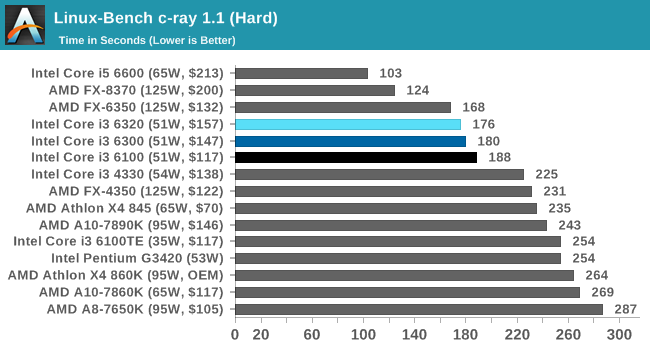
C-Ray is another bench that likes threads and high IPC cores, hence the i5-6600 sits out ahead followed by the FX-8350. At a lower price bracket, the FX-6350 with six threads wins out against the set of Core i3s, which follow their regular staircase pattern. The difference in frequency accounts for 4 seconds difference, and it seems the L3 cache difference accounts for another 4, or about 2%.
NAMD, Scalable Molecular Dynamics: link
Developed by the Theoretical and Computational Biophysics Group at the University of Illinois at Urbana-Champaign, NAMD is a set of parallel molecular dynamics codes for extreme parallelization up to and beyond 200,000 cores. The reference paper detailing NAMD has over 4000 citations, and our testing runs a small simulation where the calculation steps per unit time is the output vector.
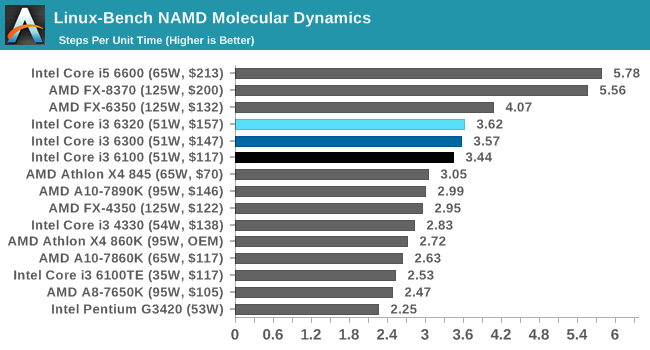
Similarly with NAMD, cores and IPC matter most. The Athlon X4 845 gets a good showing here for a $70 chip, beating the price/performance ratio of the Core i3s. Again, the AMD FX-6350 is ahead of the Core i3s, and the lopsided staircase means that the L3 cache difference accounts for another 2% loss in performance.
NPB, Fluid Dynamics: link
Aside from LINPACK, there are many other ways to benchmark supercomputers in terms of how effective they are for various types of mathematical processes. The NAS Parallel Benchmarks (NPB) are a set of small programs originally designed for NASA to test their supercomputers in terms of fluid dynamics simulations, useful for airflow reactions and design.
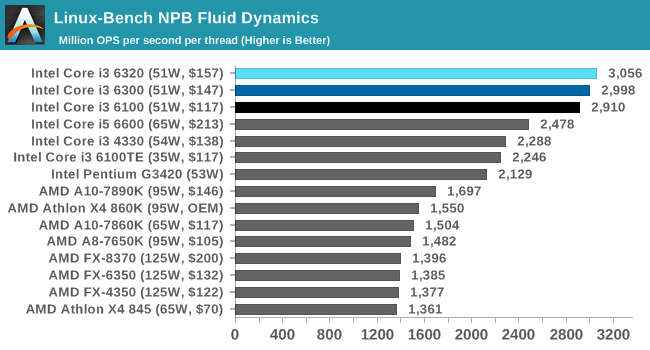
NPB clearly favors Intel CPUs, and the name of the game is IPC and frequency due to the i5 being behind the Core i3 parts. On the AMD side, the highest frequency part takes the lead and the thread count doesn't seem to matter much; neither does the microarchitecture, indicating that NPB is likely tuned for Intel.
Redis: link
Many of the online applications rely on key-value caches and data structure servers to operate. Redis is an open-source, scalable web technology with a strong developer base, but also relies heavily on memory bandwidth as well as CPU performance.
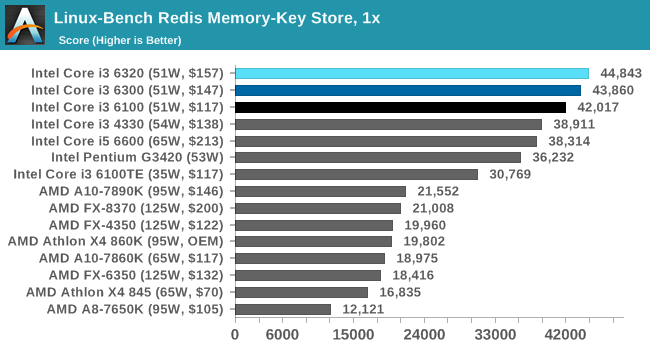

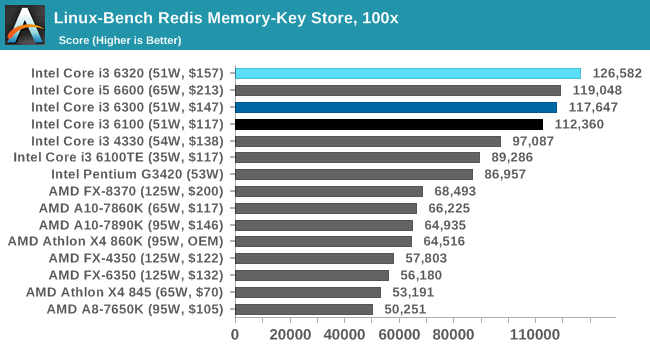
Redis is similar - high IPC and lots of fast cache are needed, and again it seems to be Intel tuned. The i5 sits below the set of Core i3s until the 100x loading comes along, where having physical cores and more cache seems to help. Despite saying more cache seems to help, the effect of the lower L3 cache on the i3-6100 seems to matter more in the 1x and 10x tests, but less in the 100x test, which is somewhat odd.










94 Comments
View All Comments
Ratman6161 - Monday, August 8, 2016 - link
I don't understand your point. Did you note how many of the tests where the i3's (sometimes just the 6320 and sometimes all of them) beat the i5? Also look at certain gaming tests where an i3 with a better graphics card beats an i5 with a lesser graphics card...i.e. if you save $100 on the CPU and put that towords the graphics instead, you sometimes come out ahead overall.Finally, I know plenty of people who are just using their PC for web surfing, email, MS Office, etc where they would not notice any difference between an i3-6100 and an i5-6600K other than the fact that it cost almost $100 more. Sometimes good enough is good enough and thats where the i3 comes in.
extide - Monday, August 8, 2016 - link
Yeah, the i3's sometimes beat the i5's because when moving from the top end i3 to the bottom end i5 you lose quite a bit of frequency, but you gain two physical cores. So, if something is very lightly threaded then it may perform better on the i3.beginner99 - Tuesday, August 9, 2016 - link
True but for the mentioned usage you can step down to a Pentium or even Celeron and save even more and not notice much of a difference.BillBear - Sunday, August 14, 2016 - link
I agree. If Android can manage to leverage many small ARM cores for common tasks like web browsing, there is no excuse for Microsoft not being able to manage the same feat on Windows.http://www.anandtech.com/show/9518/the-mobile-cpu-...
xenol - Monday, August 8, 2016 - link
Please, do more lower-end CPU reviews! This data helps me understand how software and hardware play together more and more.To those thinking that it's sad that performance hasn't really increased in the past few years, maybe this is more of a sign that games are becoming efficient. If anything, this means your hardware will go a lot longer than before. Think about it, if the i5-2500K is still a viable CPU, think about how long an i5-6600K will last.
Philotech - Monday, August 8, 2016 - link
I'd love to see the same comparison for the mobile variants of the i3/i5 chips, in particular the 15W variants suitable for ultrabooks and MacBook Pros.Looks like for desktops, as a mainstream user there is no need to look beyond the i3. How about mobile? Looking at Intel's ARK database, there aren't that many 15w i3s (one, actually, 6100U), but a few i5s (four).
dave_the_nerd - Monday, August 8, 2016 - link
That seems tough - since they're soldering into the chassis, and different cooling can result in throttling and very different performance numbers even from the same chips. It'd be really hard to make a fair CPU-to-CPU comparison.Philotech - Monday, August 8, 2016 - link
Hm, you're right probably. Seeing how small the differences between the desktop i3s and i5 is, I'm wondering if it makes any sense at all to judge a laptop or ultrabook by its CPU, in particular taking into account your point, i.e. that probably cooling (and selecting a higher or lower TDP by the manufacturer) makes much more of a difference than the CPU model.extide - Monday, August 8, 2016 - link
Well, in the mobile chips the segmentation is different. In the desktop world going from i3 to i5 you gain two cores, lose hyper threading, and gain turbo boost.In the mobile chips everything has hyper threading. Going from i3 to i5 gains you turbo boost on a mobile chip and that can be pretty significant, because on those really low TDP chips they tend to have a pretty low base speed but the ones that can boost can usually boost up quite a bit. Going to an i7 in the 15w chips add's a bit more clockspeed and you will typically move from 3MB of L3 to 4MB of L3. The best value are the i5's in the mobile world because turbo boost helps a lot, but moving to an i7 with 4MB of L3 doesnt really gain that much performance, and can be pretty costly.
So, you can't really use these results to judge the differences between mobile i3's and i5's because they are quite different.
slickr - Monday, August 8, 2016 - link
I'm waiting for AMD's Zen CPU's before I upgrade my CPU. I'm running an older I5 3330, but so far nothing is really significantly faster for the same price I bought it at the time(180 euros). Especially in games the difference seems negligible and mostly comes down to GPU.So I'm waiting on Zen as my next likely upgrade.